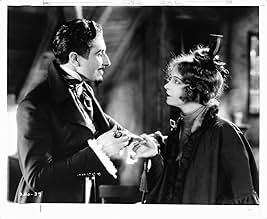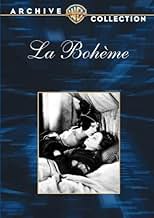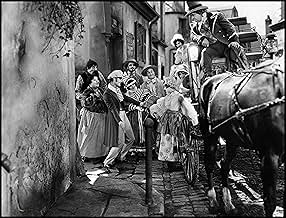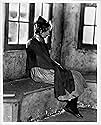NOTE IMDb
7,2/10
1,7 k
MA NOTE
Un groupe d'artistes affamés tente de survivre dans le Paris des années 1830, notamment une couturière et le futur dramaturge qu'elle aime.Un groupe d'artistes affamés tente de survivre dans le Paris des années 1830, notamment une couturière et le futur dramaturge qu'elle aime.Un groupe d'artistes affamés tente de survivre dans le Paris des années 1830, notamment une couturière et le futur dramaturge qu'elle aime.
- Réalisation
- Scénario
- Casting principal
- Récompenses
- 2 victoires au total
Mathilde Comont
- Madame Benoit
- (as Matilde Comont)
Eugene Pouyet
- Bernard
- (as Gene Pouyet)
Agostino Borgato
- Editor
- (non crédité)
Harry Crocker
- Bit Part
- (non crédité)
Blanche Payson
- Factory Supervisor
- (non crédité)
Avis à la une
Rodolphe (John Gilbert) is a wouldbe playwright struggling for that final bit of inspiration that will lead him to greatness. Mimi (Lillian Gish) is his upstairs neighbor, a seamstress and embroidery expert who works herself to the breaking point. Along with various painters, musicians and other poets, they all struggle to make ends meet until they finally have the success they all crave
The most famous bit of this one is the very ending, but I won't risk spoiling things, only to say that it's milked for all that it's worth. Gilbert looks even more like John Barrymore here, with his tousled hair and piercing eyes. Gish is her usual waifish, saintly self, although she was reportedly anything but offscreen during the making of this, her personal "love letter" to her European fans. I thought the film to be merely decent, with nothing beyond the ending to really recommend it.
The most famous bit of this one is the very ending, but I won't risk spoiling things, only to say that it's milked for all that it's worth. Gilbert looks even more like John Barrymore here, with his tousled hair and piercing eyes. Gish is her usual waifish, saintly self, although she was reportedly anything but offscreen during the making of this, her personal "love letter" to her European fans. I thought the film to be merely decent, with nothing beyond the ending to really recommend it.
In 19th century Bohemia, artistic residents in the "Latin Quarter" of Paris suffer and starve. Lillian Gish (as Mimi) is a seamstress who can't pay the rent. John Gilbert (as Rodolphe) is an playwright with money problems of his own. Gilbert has been watching Gish, who lives in the neighboring attic apartment; he is taken by her innocent waif-like beauty. On the first of the month, neither Ms. Gish nor Mr. Gilbert are able to pay the rent, when the landlord visits. Gilbert, his roommates, and friends get some cash together; but Gish, a loner, is evicted. As Gish is preparing to leave the building, Gilbert and friends rescue her from street life. Then, Gish and Gilbert fall in love.
The film is most notable for its outstanding pairing of stars Gish and Gilbert, under the star direction of King Vidor. Mr. Vidor is strangely subdued by the period, and settings; but, his Paris street scenes are terrific. The meeting of Gish and lecherous Roy D'Arcy (as Vicomte Paul) is striking; and, Gish's tubercular crawl through the streets of Paris is most especially stunning.
The lovers of "La Bohème" face poverty and misunderstanding; but, mainly, it's Gish's "Mimi" making sacrifices for Gilbert's "Rodolphe". Gish's performance is indescribable. According to Vidor and co-workers, she may have put her life in danger to make the film's ending most realistic; and, it shows. Gilbert is in fine form, and characterization; according to Gish, he proposed during film-making. Renée Adorée (as Musette) and Karl Dane (as Benoit) standout among the oddly more well-fed Bohemians.
King Vidor directing Lillian Gish and John Gilbert in a prestigious M-G-M production is, of course, well worth seeing; but, the sum of their efforts do not produce the portended masterpiece. Gish's performance seems too outer-worldly for the rest of the cast; and, the story is unworthy. Cinematographer Hendrik Sartov contributes to some beautiful imagery; although, his soft focus lens, on Gish close-ups, is distracting during the early scenes. Happily, Gish, and photographer Sartov, returned to balanced perfection, in "The Scarlet Letter" (1926).
******** La Boheme (2/24/26) King Vidor ~ Lillian Gish, John Gilbert, Renee Adoree, Roy D'Arcy
The film is most notable for its outstanding pairing of stars Gish and Gilbert, under the star direction of King Vidor. Mr. Vidor is strangely subdued by the period, and settings; but, his Paris street scenes are terrific. The meeting of Gish and lecherous Roy D'Arcy (as Vicomte Paul) is striking; and, Gish's tubercular crawl through the streets of Paris is most especially stunning.
The lovers of "La Bohème" face poverty and misunderstanding; but, mainly, it's Gish's "Mimi" making sacrifices for Gilbert's "Rodolphe". Gish's performance is indescribable. According to Vidor and co-workers, she may have put her life in danger to make the film's ending most realistic; and, it shows. Gilbert is in fine form, and characterization; according to Gish, he proposed during film-making. Renée Adorée (as Musette) and Karl Dane (as Benoit) standout among the oddly more well-fed Bohemians.
King Vidor directing Lillian Gish and John Gilbert in a prestigious M-G-M production is, of course, well worth seeing; but, the sum of their efforts do not produce the portended masterpiece. Gish's performance seems too outer-worldly for the rest of the cast; and, the story is unworthy. Cinematographer Hendrik Sartov contributes to some beautiful imagery; although, his soft focus lens, on Gish close-ups, is distracting during the early scenes. Happily, Gish, and photographer Sartov, returned to balanced perfection, in "The Scarlet Letter" (1926).
******** La Boheme (2/24/26) King Vidor ~ Lillian Gish, John Gilbert, Renee Adoree, Roy D'Arcy
No one else but Lillian Gish would have starved herself for three days to make the final scene, and no one else would have done it so effectively. Would a modern actress have allowed herself to be dragged physically across the cobblestone streets?
I have seen hundreds of silent films by now, but I have never, ever yet seen a film in which pantomime was so wildly and dramatically used consistently throughout the entire story by the actors, particularly by John Gilbert. I hate to say it, but here as Rudolphe, although he was his usual fantastically handsome self, he reminds me most of Gene Kelly's antics in the silent film spoof musical "Singin' in the Rain." The film required more subtlety from Mr. Gilbert here, and then I think it would have been a genuine classic.
That said, there are moments where his pantomime is perfectly poignant, more genteel, and realistic. The romp through the woods on a spring day, where Mimi (Gish) confesses to Rudolphe (Gilbert) that she loves him, is sublime and unforgettable. He places his hand gently on his heart in surprise, and then kisses Mimi's golden ringlets first, before he kisses her face. A gesture so nineteenth century! John Gilbert certainly knew his history and researched his roles very well.
Lillian Gish is always a joy to watch, and her performance as Mimi is exceptional. Her death scene was very moving. If you are a fan of John Gilbert or Lillian Gish, don't miss La Boheme. TCM has a wonderful video clip from the film on its website. Just use their search engine to find it.
That said, there are moments where his pantomime is perfectly poignant, more genteel, and realistic. The romp through the woods on a spring day, where Mimi (Gish) confesses to Rudolphe (Gilbert) that she loves him, is sublime and unforgettable. He places his hand gently on his heart in surprise, and then kisses Mimi's golden ringlets first, before he kisses her face. A gesture so nineteenth century! John Gilbert certainly knew his history and researched his roles very well.
Lillian Gish is always a joy to watch, and her performance as Mimi is exceptional. Her death scene was very moving. If you are a fan of John Gilbert or Lillian Gish, don't miss La Boheme. TCM has a wonderful video clip from the film on its website. Just use their search engine to find it.
It's difficult to imagine what going to the movies was like during the Silent Era. With no soundtracks, and a person in the theater simply accompanying the on-screen action on piano, dramas of the day must have suffered somewhat. But not 'La Boheme'.
As this wonderfully engaging tale of struggling actors and writers in France unfolds, it has a quality to its story telling that would have diminished had it been a talkie. Once you see the frail and beautiful (and quite haunting) Lillian Gish in her key scenes, you will never forget her.
Grab a few hankies and enjoy this singular silent screen treat!
As this wonderfully engaging tale of struggling actors and writers in France unfolds, it has a quality to its story telling that would have diminished had it been a talkie. Once you see the frail and beautiful (and quite haunting) Lillian Gish in her key scenes, you will never forget her.
Grab a few hankies and enjoy this singular silent screen treat!
Le saviez-vous
- AnecdotesJohn Gilbert was infatuated with Lillian Gish and would mess up his "love scenes" with her on purpose, so he could keep kissing her.
- GaffesThe opening shot of Paris shows Notre Dame Cathedral with its famous spire. At the time the film is set, the 1830s, the spire did not exist. The original was demolished in the early 1790s and not rebuilt until 1860.
- Citations
Title Card: Paris - Mother of the Arts...
- ConnexionsFeatured in American Masters: Lillian Gish: The Actor's Life for Me (1988)
Meilleurs choix
Connectez-vous pour évaluer et suivre la liste de favoris afin de recevoir des recommandations personnalisées
Détails
- Date de sortie
- Pays d’origine
- Langue
- Aussi connu sous le nom de
- La Boheme
- Lieux de tournage
- Arcadia, Californie, États-Unis(elaborate picnic in the woods of Ville-d'Avray)
- Société de production
- Voir plus de crédits d'entreprise sur IMDbPro
Box-office
- Budget
- 693 000 $US (estimé)
- Durée
- 1h 35min(95 min)
- Mixage
- Rapport de forme
- 1.33 : 1
Contribuer à cette page
Suggérer une modification ou ajouter du contenu manquant

































